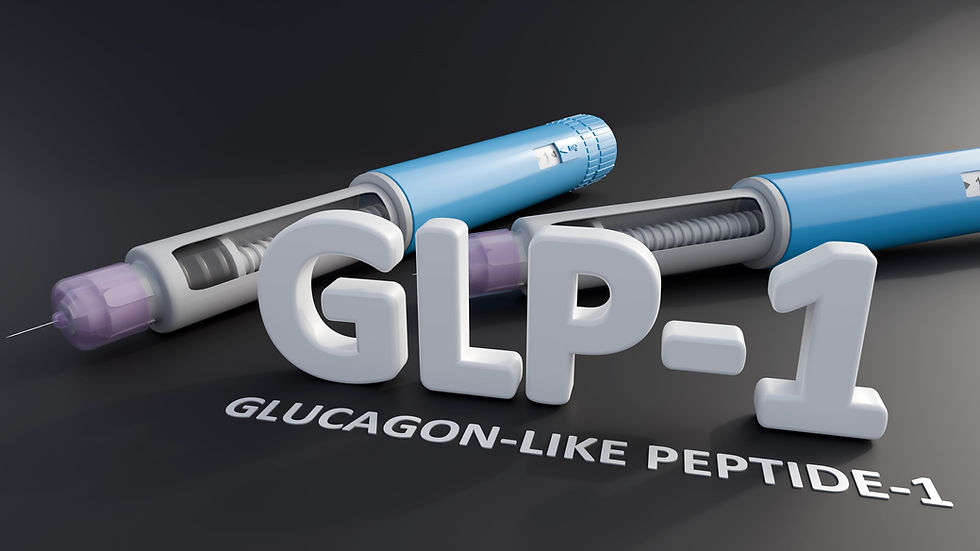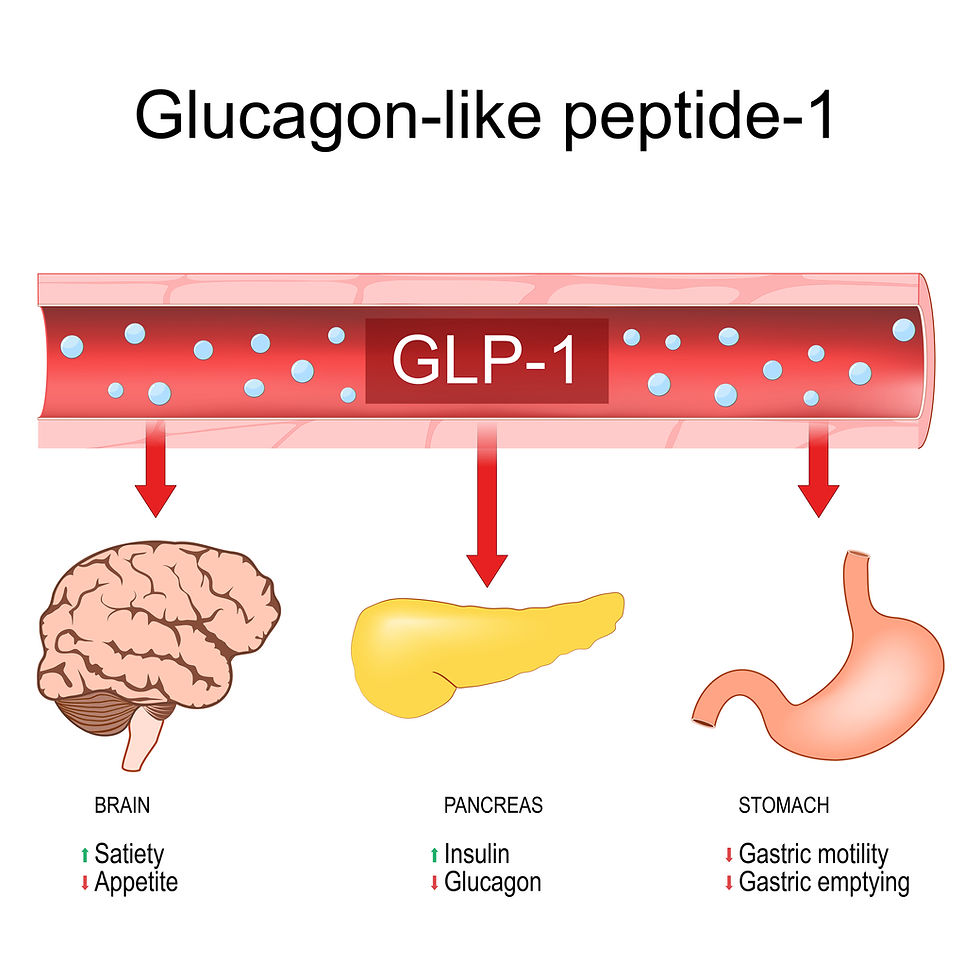Part 2: GLP-1s: The Lived Reality & Building Health Naturally
- Julie Hodgson
- Oct 6
- 6 min read

In Part 1 (which you can read here if you haven’t already), I discussed how GLP-1 medications work, and how they can be a valid option in the right circumstances to help promote weight loss, reduce appetite, and enhance metabolic function. I also discussed the real and significant risks of these medications.
I have had lots of questions on this topic, so I thought I'd explore it a bit further. Here, in part 2, I have tried to answer a lot of these questions and will aim to cover the lived reality of taking these medications, what it takes for real transformation, and how you can support the very same mechanisms they target, whether you choose the medication or not, to build long-term health naturally.
My passion is helping people build the habits so that, whether they choose medication or not, they’re set up for sustainable energy, strength, resilience and independence as they age. As previously mentioned, a lot of these thoughts are just that, purely my views on the subject alongside my training in functional nutrition.
What’s happening when you’re on these medications, and how you can use diet and lifestyle to nurture the same processes.
They lower your appetite, meaning you feel satisfied faster, the food noise quiets, you may stop thinking about food all the time, and cravings ease. Food addiction is a real problem for some people, causing a lot of stress and overwhelm around food, so much so that it is now being recognised as a real disorder alongside other eating disorders. (I’m currently doing further training in this area, as it is something I’m seeing impact more and more people every day)
It is entirely possible to naturally lower your appetite: Eating protein and fibre with every meal helps your own satiety hormones kick in. Mindful eating, slowing down at meal times, and noticing fullness help train your brain to recognise and trust these signals.
Sometimes what feels like “hunger” is actually an emotional need, stress, boredom, loneliness, or fatigue. Learning to pause, check in, and meet that need in another way (walk, breathwork, journaling, a chat with a friend, nutritional therapy 😉 or talking therapy) can break this food loop and help you feel better around food.
Just my thoughts - Medication may quieten symptoms, but it doesn’t fix the deeper issues, such as an abundance of ultra-processed foods, stress, poor sleep, lack of movement, low self-esteem and the emotional pressures of modern life. Those challenges don’t disappear, and they will resurface once the drugs stop. Getting the right support to address them is what truly makes the difference.
They slow stomach emptying and help you feel fuller for longer because food moves more slowly through the digestive system.
Balanced meals, especially those rich in protein, healthy fats, and fibre, naturally slow your digestion. Eating without distractions and chewing thoroughly also enhances this effect.
Emotional eating can override fullness and satiety signals. Practices like stress management, meditation, or simply naming the feeling (I’m anxious or stressed, not hungry, for example) can help you recognise the real underlying need.
They help balance blood sugar by boosting insulin and lowering glucagon, another hormone produced in the pancreas, which together keep blood sugar steadier after meals.
Lowering refined and starchy carbohydrates, pairing carbs with protein or fat, taking a short walk after meals, prioritising protein at breakfast and carrying out regular resistance training are some of the most powerful ways to improve insulin sensitivity and balance your blood sugar naturally.
Blood sugar highs and lows from refined carbohydrates and/ or not enough protein can worsen mood swings and cravings. Supporting emotional balance through sleep, stress management, and balanced meals reduces the rollercoaster or the "peaks and troughs" of blood sugar that drive overeating.
They dampen reward pathways linked to food addiction. That strong urge to eat or the "pull" toward sugar and processed foods fades.
The right diet with the correct macronutrient ratio for you stabilises dopamine swings that can drive addiction, while activities such as exercise, connection and joy give your brain other, healthier sources of reward.
Many of us reach for food to soothe or numb our emotions. Learning other coping tools, such as breathwork, stretching, grounding practices, or talking it through, helps separate food from feelings.
Diet and lifestyle are often trivialised next to big pharma and prescription medications, which are designed to override your biochemistry to create an effect, not to build health. The above strategies may seem like effort and hard work, but they are really just innate human habits, eating real food, moving daily, resting well, managing stress, connection and joy, and are ultimately more powerful and sustainable than any medication. Whether you take medication or not, they are the foundation which should be supported aongside.
Tips for increasing the GLP-1 hormone in your body naturally
Practice meal sequencing - Eat protein, fibre, and healthy fats before carbs at meals to slow digestion and stabilise your blood sugar. This promotes the release of GLP-1 in your gut.
Ensure 2 - 3 meals per day - One of the most powerful things, yet most simple, is to ensure you eat 2- 3 adequate meals per day containing the appropriate macronutrient ratio for you. 2 may be sufficient if you have balanced hormonal control, 3 if just starting out.
Take 2 tsp ground flaxseeds before meals - Slows digestion, gastric emptying, and enhances satiety.
Add 1–2 tbsp chia seeds daily (soaked in water, in a smoothie or with your porridge or yoghurt) - Provides gel-forming fibre that boosts GLP-1 naturally.
Eat ½ cup beans or lentils with meals - Rich in fibre and protein, both are shown to stimulate GLP-1.
Ensure 20 - 30g of protein at each meal - Protein such as eggs, meat, fish, tofu, or Greek yoghurt helps trigger satiety hormones.
Drizzle 1 tbsp of olive oil or avocado oil on salads or put a knob of butter on your veggies - Healthy fats support GLP-1 secretion and fullness as well as help the absorption of fat-soluble nutrients.
Enjoy polyphenol-rich foods - Green tea, a handful of berries, or a square of dark chocolate provide polyphenols that improve gut health and GLP-1 release.
Add fermented foods (sauerkraut, kimchi, kefir) a few times per week. Nourish your microbiome, which plays a role in GLP-1 production.
Take a 10 - 15 min walk after meals - Helps with the uptake of glucose into your muscles, which lowers glucose levels and improves glucose control. Exercise also improves GLP-1 release and function.
⚠️ The Lived Reality of Side Effects
GLP-1s often bring nausea, constipation, or a lack of interest in food. This can lead to under-eating and compromised digestion, and is shown to reduce intake or absorption of key nutrients like protein, iron, vitamin B12, folate, vitamin D, calcium, magnesium, potassium, zinc, and other fat-soluble vitamins (A, D, E, K).
As discussed in part 1, rapid weight loss without adequate nutrition or movement can mean losing not just fat, but muscle and bone, which are essential for long-term strength and independence. There are real and significant risks with these medications. However, for those who are severely overweight and at high risk of conditions like diabetes, heart disease, and other comorbidities, the benefits may outweigh the downsides.
This is the real transformation! The part that stays with you, long after a prescription ends (or even if you never start one at all).
My final Thoughts 😊
GLP-1s can be powerful, especially if food noise has felt overwhelming. But you can support every mechanism they target, such as appetite, fullness, blood sugar, cravings and reward pathways naturally with nutrition, movement, stress management, and emotional awareness. Seeking support if you need.
The lived reality I want for you isn’t just freedom from food chatter, but the confidence of knowing you can meet cravings, triggers, and emotions with strength, clarity, and habits that truly last.
The real goal isn’t just weight loss - it’s protecting your strength, independence, and vitality as you age.
If you have any more questions, please do get in touch!
I would love to hear from you.
Julie x
Helping you live a healthier, happier life
I help busy adults 35+ struggling with low energy, brain fog, stress, chronic health issues, and weight gain.





Comments